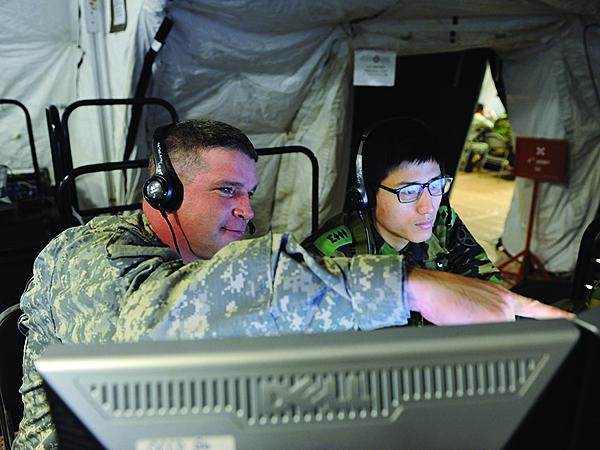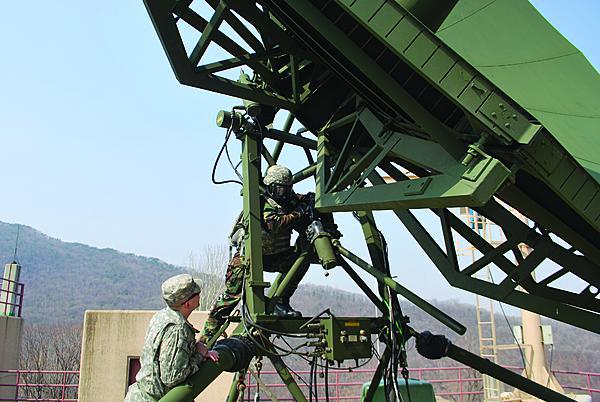Korean Military Networks Flourish Under Duress
The signal brigade in charge of U.S. Army communications in the Republic of Korea is incorporating new technologies and capabilities with one eye on ensuring success and the other eye on the hostile neighbor to the north. System improvements such as the advanced Warfighter Information Network-Tactical, voice over Internet protocol and a Korean theater version of the Joint Information Environment are designed to give allied forces a significant edge should war break out.
Yet, implementing these top-of-the-line technologies and capabilities is complicated by both the nature of the threat and the nature of the alliance. All the U.S. services have advanced warfighting assets serving the peninsula, and these must interoperate with Republic of Korea (ROK) forces and others under U.N. command. The omnipresent North Korean military offers no respite to allied vigilance, and this constant threat affects the ability to upgrade technology.
“We operate in a joint and combined environment every day here on the peninsula,” states Col. Paul H. Fredenburgh III, USA, commander of the 1st Signal Brigade. He notes the brigade is in the midst of a major transformation in Korea, and much of this transition owes the U.S. strategic pivot toward the Asia-Pacific region. Korea is a linchpin in the Pacific pivot, and changes wrought by this pivot are funded, which is a key for their implementation, the colonel allows.
Just keeping up with new technology presents its own challenge in Korea. The brigade must implement it “in an optempo and timing that never costs us our edge in readiness,” Col. Fredenburgh declares. The brigade considers criteria such as how much upgrading can be done at once and the best time for scheduling it. Even with careful planning, external events—especially words or deeds coming from North Korea—can overtake scheduled upgrades and change plans. “Everything we do is integrated into our intelligence and operations posture,” he says.
“Obviously, because of the readiness state we have to maintain here, we just can’t go into ‘admin pause’ and take everything down,” the colonel points out. “So, we’re rolling our systems through so we maintain a certain number of systems on ready standby.
“I can’t express enough how important it is that all these technology implementations we’re doing out here are closely coordinated with our operations and intelligence,” he emphasizes.
These changes are proceeding concurrent with major infrastructure upgrades. The brigade is replacing its switches and routers as well as enhancing all aspects from survivability to resiliency. But, in the midst of these upgrades, the communicators must maintain readiness. “We have to be ready to fight tonight,” Col. Fredenburgh declares. “So, we are constantly evaluating our network and implementing changes to make it more resilient, more reliable and more robust. Those things are happening each and every day.”
One of the brigade’s unique features is its Joint Command Information Systems Agency, or JCISA, the colonel offers. This group is the joint and combined arm of the brigade, and it operates and maintains Korean forces networks.
The 1st Signal Brigade has both tactical and strategic missions, Col. Fredenburgh points out. That permits the brigade to focus on top-to-bottom services. One effort that is coordinated among the U.S. Forces Korea J-6 and the 8th Army G-6 is known as the Joint Information Environment (JIE)-Korea. As the Korean element of the defensewide JIE, this effort represents the single vision of the local communications architecture from tactical to strategic, he notes.
About 85 percent of Korean forces communications services are provided by the brigade, the colonel offers. Other military service networks tend to be external and extended onto the Korean peninsula. The JIE-Korea will be the single joint network that provides necessary services to users in that theater. The brigade has working groups and tiger teams for JIE transport and services, for example, and these groups are working directly with the Defense Department and the U.S. Pacific Command in an integrated effort.
The brigade is consolidating and virtualizing many of its services. It already has finished these efforts on its Combined Enterprise Regional Information Exchange System (CENTRIXS) network and nonsecure Internet protocol router network (NIPRNET), the colonel relates. Two years ago, Gen. James D. Thurman, USA, commander of U.S. Forces Korea, designated CENTRIXS-Korea as the Korean mission network. Col. Fredenburgh describes it as a U.S.-ROK releasable network jointly operated at the secret level by both coalition members. It will be the network of choice should combat break out on the Korean peninsula. Its services have been virtualized at the strategic level, the colonel notes.
Army warfighting systems, all the way down to the battalion or even company level, have been placed on the CENTRIXS-Korea network, he says. Moving these capabilities from the U.S. Army-Secret to the coalition network enables greater interoperability and information sharing among alliance partners. The colonel adds that a large contingent of U.N. states sent forces to a recent training event in August. The brigade continues to deal with interoperability challenges at the tactical echelons, he admits.
All of these changes are taking place against the backdrop of a major force reallocation throughout the peninsula. Known as the Yongan Relocation Program (YRP) Land Partnership Program (LPP), this effort involves consolidating the majority of U.S. forces into two major hubs: U.S. Army Garrison Humphreys and Osan Air Base; and U.S. Army Garrison Daegu and Chinhae Naval Base. U.S. forces are moving south of the Han River and away from the Seoul metropolitan area.
The 1st Signal Brigade is building “a world-class communications center” at U.S. Army Garrison Humphreys to which it will migrate its services, the colonel states. The brigade’s 304th Expeditionary Signal Battalion already has moved from Camp Stanley to U.S. Army Garrison Humphreys. It was the first battalion to make this move, and the brigade treated it as an operational move where the battalion was able to hit the ground running upon arrival. At any time during that move, the battalion would have been able to respond to a call for operational action, the colonel observes.
This need to maintain services will continue throughout the migration. The brigade is rolling out voice over Internet protocol (VoIP) services, and it has been adjusting its communications infrastructure to meet the needs of the consolidation. Col. Fredenburgh says signaleers have stopped laying copper wire to buildings and instead are relying exclusively on fiber to meet VoIP requirements. VoIP services will be extended beyond U.S. Army Garrison Humphreys, he notes.
The virtualization effort is replacing individual rack-mounted servers with blade servers that allow virtualization of services. The result is less power consumption and a smaller equipment footprint with more efficient use of computing capacity. This virtualization aids survivability significantly, the colonel adds, by enabling automatic replication of services between the northern and southern nodes. “It makes it much easier to manage continuity of operations from one site to the other,” he observes.
The brigade’s Warfighter Information Network-Tactical (WIN-T) is equipped with a third stack that permits simultaneous extension of NIPRNET, the secret Internet protocol router network (SIPRNET) and CENTRIXS into the tactical environment. All these services can be provided to the warfighting command posts, the colonel observes.
A WIN-T Increment 1b upgrade has begun, and it should be completed before the end of November, Col. Fredenburgh notes. This will provide “colorless corps routing” for tactical links, he continues, and will enable access to the Net Centric Waveform that will ensure compatibility with the next Increment 2 upgrade.
Col. Fredenburgh says the biggest challenge the brigade faces entails synchronizing all of its transformation efforts, particularly with regard to understanding the requirements of operational commanders so the brigade can translate those requirements into an enabling technology; attain necessary funding; and coordinate implementation, training, operations and maintenance. This challenge extends at all levels throughout the communications community, he notes.
As with all signal organizations, the brigade is increasing its emphasis on cyber, which represents another major challenge. Col. Fredenburgh declares that the cyberthreat is evolving as fast as—or faster than—its enabling technologies, and keeping ahead of that curve is difficult. Amid the standups of the U.S. Cyber Command and the individual service cyber commands, the brigade has an enhanced mission. Its defensive cyber operations are increasing in size and importance.
A Korean theater network operations center along with a regional computer emergency response team are key elements for dealing with defensive cyber issues. Col. Fredenburgh allows that the brigade works closely on cyber with other services and alliance partners in a joint and combined environment.
The brigade aims to turn its joint cyber center into a joint and combined effort, the colonel offers. The brigade shares cyber information with its ROK partners based on Defense Department and intelligence community guidelines. Cyber represents a key vulnerability facing allied forces on the peninsula, so the brigade is improving its vital data exchanges with its Korean allies.
Three years from now, the 1st Signal Brigade likely will be a more modern and leaner organization, Col. Fredenburgh offers. The ongoing force consolidation in Korea will achieve efficiencies, he notes. And, as unified capabilities become more integrated, new services also will make the organization much more capable. “We’ll be able to extend more capabilities with more throughput and faster speed into our tactical operations as we incorporate these enhancements and upgrades,” he predicts.






Comments